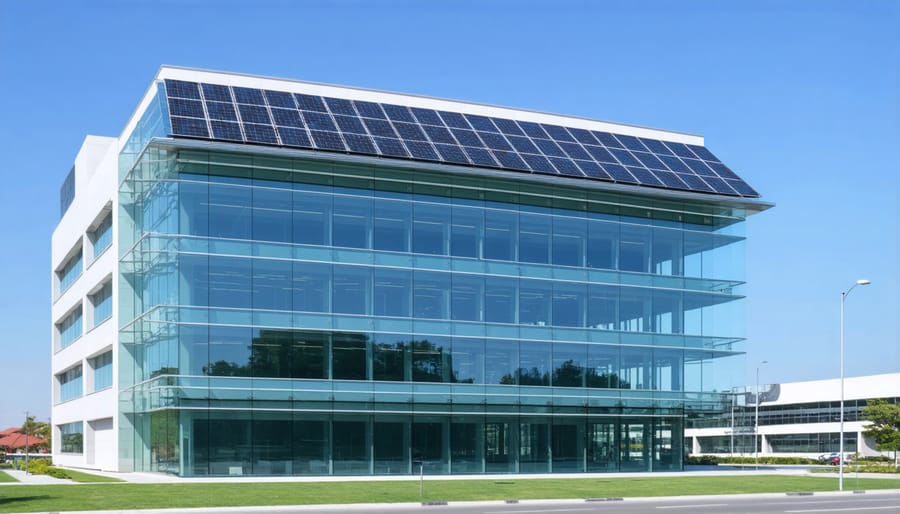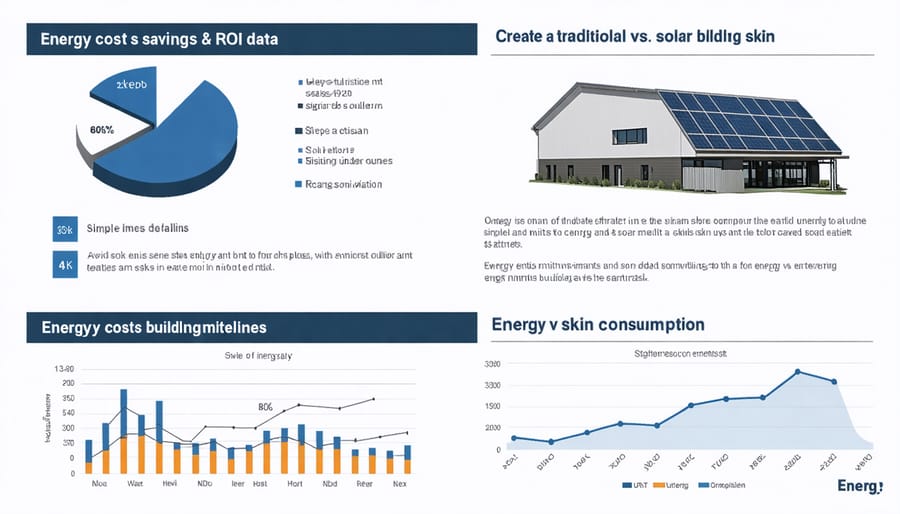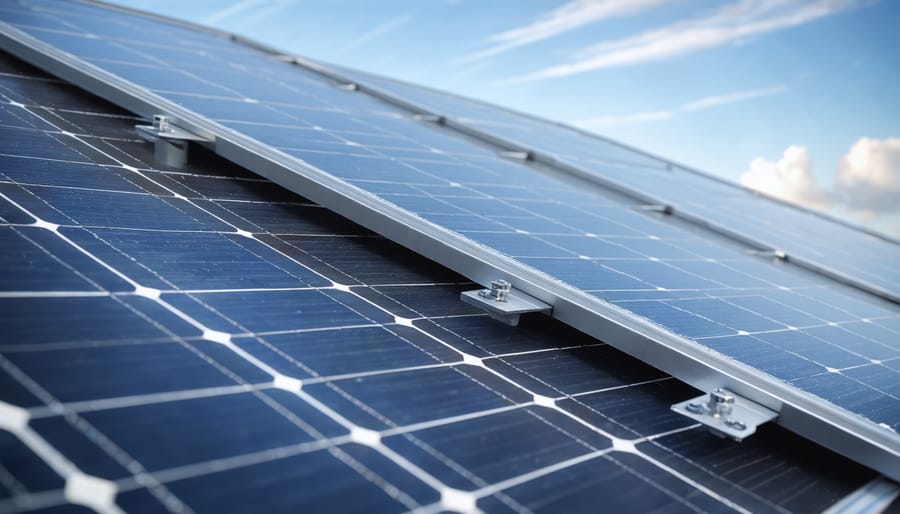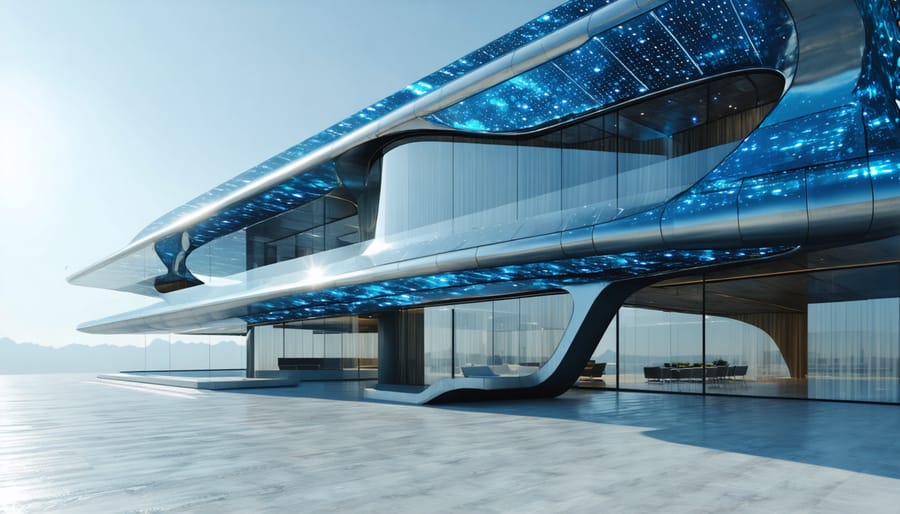Solar-Integrated Building Skins Transform Modern Architecture (While Slashing Energy Bills)
Transform your building into a clean energy powerhouse with solar panels that seamlessly blend architecture and sustainability. Modern solar-integrated building skins have revolutionized how we think about renewable energy in construction, moving beyond traditional rooftop installations to create structures that generate power from virtually every surface. These innovative systems can reduce energy costs by 50-70% while increasing property value and creating a striking visual statement.
From sleek solar facades that double as windows to solar roof tiles that mimic traditional materials, today’s building-integrated photovoltaics (BIPV) offer property owners unprecedented options for combining form and function. Leading architects and developers are embracing this technology to create zero-energy buildings that produce as much power as they consume, setting new standards for sustainable architecture.
Whether you’re planning a new construction project or retrofitting an existing structure, solar-integrated building solutions represent the future of sustainable architecture. With advances in efficiency and aesthetics, plus declining installation costs and generous tax incentives, there’s never been a better time to explore how solar technology can transform your property into an energy-generating asset.
How Solar Building Skins Revolutionize Architecture
Beyond Traditional Solar Panels
The world of solar technology has evolved far beyond traditional panels, offering innovative solutions that seamlessly integrate with building materials. One of the most exciting developments is solar shingles, which look like regular roof tiles but harness the sun’s power just like conventional panels. These smart building materials come in various forms, including solar glass windows that generate electricity while maintaining transparency, and solar facade elements that transform entire building walls into power generators.
Building-integrated photovoltaics (BIPV) have revolutionized how we think about solar power in construction. Instead of adding solar panels as an afterthought, these materials serve dual purposes – they’re both functional building components and energy generators. Some innovative products include solar awnings that provide shade while producing power, and even solar paint that could turn any surface into an energy-collecting area.
These alternatives often appeal to property owners who want to maintain their building’s aesthetic appeal while embracing renewable energy. They’re particularly popular in historic districts where traditional solar panels might not meet architectural guidelines.
Seamless Integration Techniques
Modern architects and builders are revolutionizing how we integrate solar technology into buildings, making them both aesthetically pleasing and energy-efficient. The latest smart solar facades seamlessly blend with traditional building materials, creating a unified appearance while maximizing energy generation.
One popular technique is the use of solar roof tiles, which replace conventional roofing materials with photovoltaic modules that match the look of standard tiles. These integrate perfectly with the roof’s design while providing clean energy. Another approach involves building-integrated photovoltaic (BIPV) windows, which use transparent or semi-transparent solar cells within the glass panels.
Solar cladding systems offer another elegant solution, replacing traditional wall materials with solar-active surfaces. These can be customized in various colors and textures to match the building’s architectural style. For renovation projects, solar awnings and canopies provide an excellent way to add solar capability without major structural changes.
The key to successful integration lies in early planning, allowing solar elements to become part of the building’s DNA rather than an afterthought. This approach not only enhances the building’s appearance but also maximizes energy production potential.

Real-World Benefits of Solar Building Skins
Energy Cost Savings
Installing solar panels can lead to substantial energy cost savings over time, making them an attractive investment for both homeowners and businesses. On average, property owners can expect to reduce their electricity bills by 50-75% after installing solar panels, with some achieving complete energy independence.
The return on investment (ROI) typically ranges from 5 to 8 years, depending on factors like local electricity rates, solar intensity, and available incentives. For example, a typical residential installation costing $20,000 can save approximately $1,500 annually on energy bills, while also increasing property value by 4-6%.
Commercial buildings often see even more dramatic savings, with some large-scale installations paying for themselves in as little as 3-4 years. Many businesses report monthly energy savings of $1,000 or more, particularly in regions with high electricity rates or strong solar incentives.
The financial benefits extend beyond direct energy savings. Many utility companies offer net metering programs, allowing property owners to sell excess energy back to the grid. Additionally, federal tax credits currently cover 30% of solar installation costs, while state and local incentives can further reduce initial expenses.
To maximize savings, consider factors like panel efficiency, optimal positioning, and regular maintenance. Modern solar systems also come with monitoring apps that help track energy production and consumption in real-time, allowing owners to optimize their usage patterns for maximum financial benefit.

Environmental Impact
Buildings equipped with solar panels make a significant positive impact on our environment by substantially reducing carbon emissions and dependence on fossil fuels. A typical residential solar installation can prevent approximately 3-4 metric tons of carbon emissions annually – equivalent to planting over 100 trees. This transformation in sustainable building design represents a crucial step toward combating climate change.
Beyond carbon reduction, solar-equipped buildings help conserve water resources traditionally used in conventional power generation. They also minimize air pollution by reducing the need for coal and natural gas-fired power plants, leading to improved air quality in urban areas. The environmental benefits extend throughout the solar panel’s 25-30 year lifespan, making them a long-term investment in our planet’s health.
Solar panels also contribute to reducing urban heat island effects, as they absorb solar radiation that would otherwise be absorbed by building roofs. This helps regulate local temperatures and decrease cooling needs. Additionally, modern solar installations often incorporate rainwater harvesting systems and green roof elements, creating comprehensive environmental solutions that support local biodiversity and sustainable water management.
When buildings transition to solar power, they not only become energy producers but also active participants in environmental conservation, setting a powerful example for future construction projects and community development.
Implementation Considerations
Planning and Design Phase
The successful implementation of solar panels on your building starts with thorough planning and thoughtful design. As solar integration in modern architecture becomes increasingly sophisticated, several key factors need careful consideration before installation begins.
First, assess your building’s solar potential by evaluating roof orientation, angle, and available space. South-facing surfaces typically receive maximum sunlight exposure in the Northern Hemisphere, while east and west-facing surfaces can still be viable options. Consider any potential shade from nearby structures, trees, or other obstacles that might affect solar panel performance throughout the day.
Your building’s structural integrity plays a crucial role in supporting the additional weight of solar panels and mounting systems. Have a qualified engineer evaluate your roof’s condition and load-bearing capacity. This assessment helps determine if reinforcement is needed before installation.
Energy requirements should guide your system sizing. Review your current electricity consumption patterns and future needs to determine the optimal number of panels. Consider seasonal variations in energy use and any planned changes to your building’s energy demands.
Local regulations and building codes significantly impact your solar project. Research permit requirements, homeowners’ association guidelines, and any historic district restrictions that might affect installation. Many jurisdictions offer incentives and tax benefits for solar adoption, so investigate these opportunities during the planning phase.
Lastly, consider the aesthetic impact of solar panels on your building’s appearance. Modern solar solutions offer various designs and mounting options that can complement your building’s architecture while maximizing energy production.

Installation and Maintenance
Installing solar panels on your building is a well-structured process that typically takes between 2-5 days for residential properties and longer for commercial buildings. The journey begins with a thorough site assessment, where professionals evaluate your roof’s condition, angle, and sun exposure to determine the optimal panel placement.
Before installation, your roof must be inspected and potentially reinforced to support the additional weight. The mounting system is then secured to your roof using specialized brackets and flashing to prevent water leakage. Next, the solar panels are carefully positioned and connected to form arrays, followed by the installation of inverters that convert DC power to usable AC electricity.
Maintenance is surprisingly straightforward, making solar panels a user-friendly renewable energy solution. Regular cleaning is essential, typically needed 2-4 times per year depending on your local environment. Many homeowners handle basic cleaning themselves using specialized long-handled brushes and water, though professional cleaning services are available.
Annual professional inspections are recommended to check electrical connections, mounting hardware, and overall system performance. Most systems come with monitoring apps that alert you to any performance issues, making it easy to track your energy production and spot potential problems early.
“Our solar panels have been incredibly low-maintenance,” says Sarah Chen, a homeowner in California. “We clean them twice a year and have an annual check-up. The monitoring app gives us peace of mind that everything’s working properly.”
Remember that quality installation is crucial for long-term performance. While DIY installation might be tempting, working with certified professionals ensures your system meets safety standards and performs optimally for its 25-30 year lifespan.
Success Stories and Case Studies
The Copenhagen International School stands as a shining example of solar integration done right. Completed in 2017, the building features over 12,000 colored solar panels that not only power the facility but also create a stunning sea-blue aesthetic that perfectly complements its harbor location. The school generates more than half of its annual electricity needs while teaching students about sustainable living through real-world application.
In California, the Apple Park campus showcases how commercial buildings can maximize solar potential. The spaceship-like headquarters houses one of the world’s largest rooftop solar installations, generating 17 megawatts of power and demonstrating that corporate architecture can be both beautiful and sustainable.
The Edge building in Amsterdam has earned recognition as one of the most sustainable office buildings globally. Its solar panels, combined with other green technologies, help the building achieve an impressive 98% reduction in electricity usage compared to traditional office buildings. Employees report higher satisfaction levels and increased productivity in this environmentally conscious workspace.
For residential success stories, the Drake Landing Solar Community in Canada proves that solar technology works even in colder climates. This neighborhood of 52 homes uses solar thermal collectors to meet 90% of their space heating needs, setting a world record for solar energy efficiency in a residential development.
The Bullitt Center in Seattle, known as the greenest commercial building in the world, demonstrates the feasibility of net-zero energy construction. Its rooftop solar array produces 60% more energy than the building consumes annually, despite Seattle’s notorious cloudy weather. The success of this six-story structure has inspired numerous similar projects across the Pacific Northwest.
Small-scale implementations have been equally impressive. The Thompson family in Arizona transformed their traditional suburban home with integrated solar roof tiles, reducing their energy bills by 95% and increasing their property value by $45,000. Their story has inspired dozens of neighbors to follow suit, creating a ripple effect throughout their community.
These success stories share common elements: careful planning, commitment to sustainability, and a focus on long-term benefits over initial costs. They prove that solar integration in buildings isn’t just environmentally responsible – it’s economically smart and aesthetically pleasing.
The integration of solar panels into building design represents more than just a technological advancement – it’s a crucial step toward a sustainable future. As we’ve explored throughout this article, solar building skins offer numerous benefits, from significant energy cost savings to enhanced property values and reduced carbon footprints. The technology has matured considerably, making it more accessible and efficient than ever before.
Property owners who embrace solar integration are not just making a smart financial investment; they’re contributing to a cleaner, more sustainable world. With various design options available, from traditional rooftop installations to innovative solar facades, there’s a solution for virtually every building type and architectural style.
The success stories we’ve shared demonstrate that solar-integrated buildings are no longer just a concept of the future – they’re a practical reality today. Whether you’re a homeowner looking to reduce utility bills or a commercial property manager aiming to achieve sustainability goals, the time to consider solar integration is now.
Remember, while the initial investment may seem substantial, the long-term benefits – both environmental and financial – make it a worthwhile consideration. With government incentives, improving technology, and increasing energy costs, solar building skins are becoming more attractive than ever. Take the first step today by consulting with solar professionals to explore how your building can become part of the renewable energy revolution.









